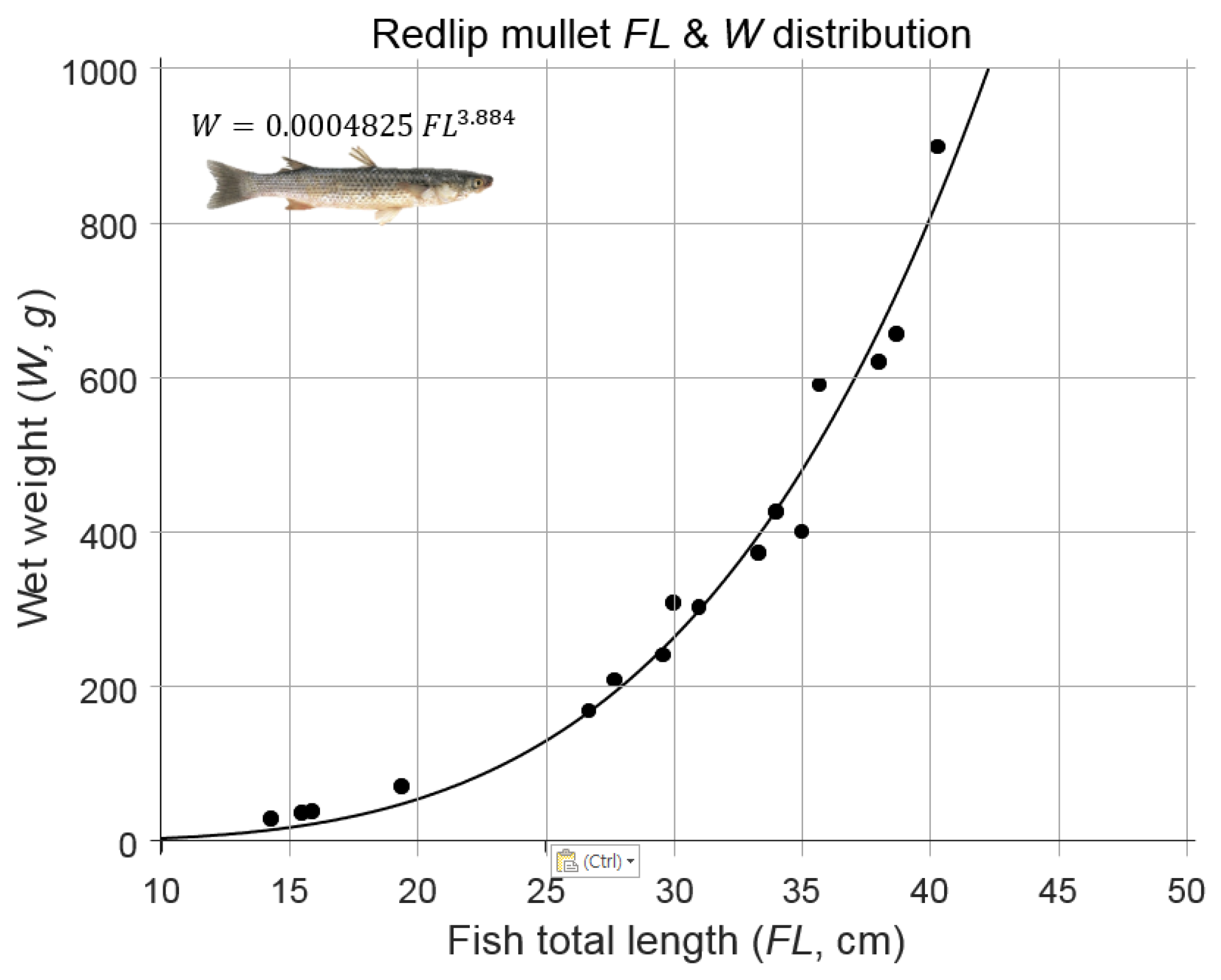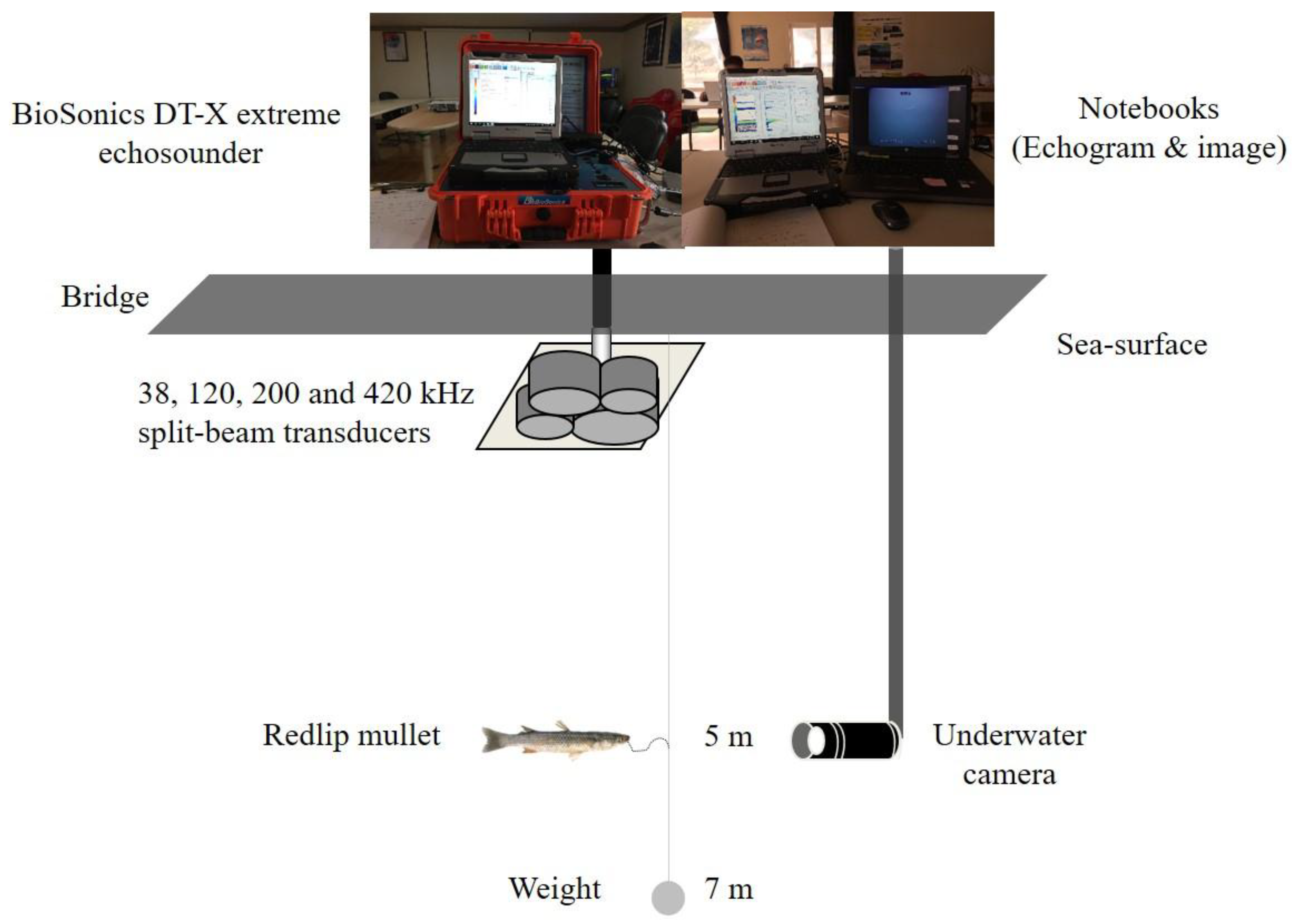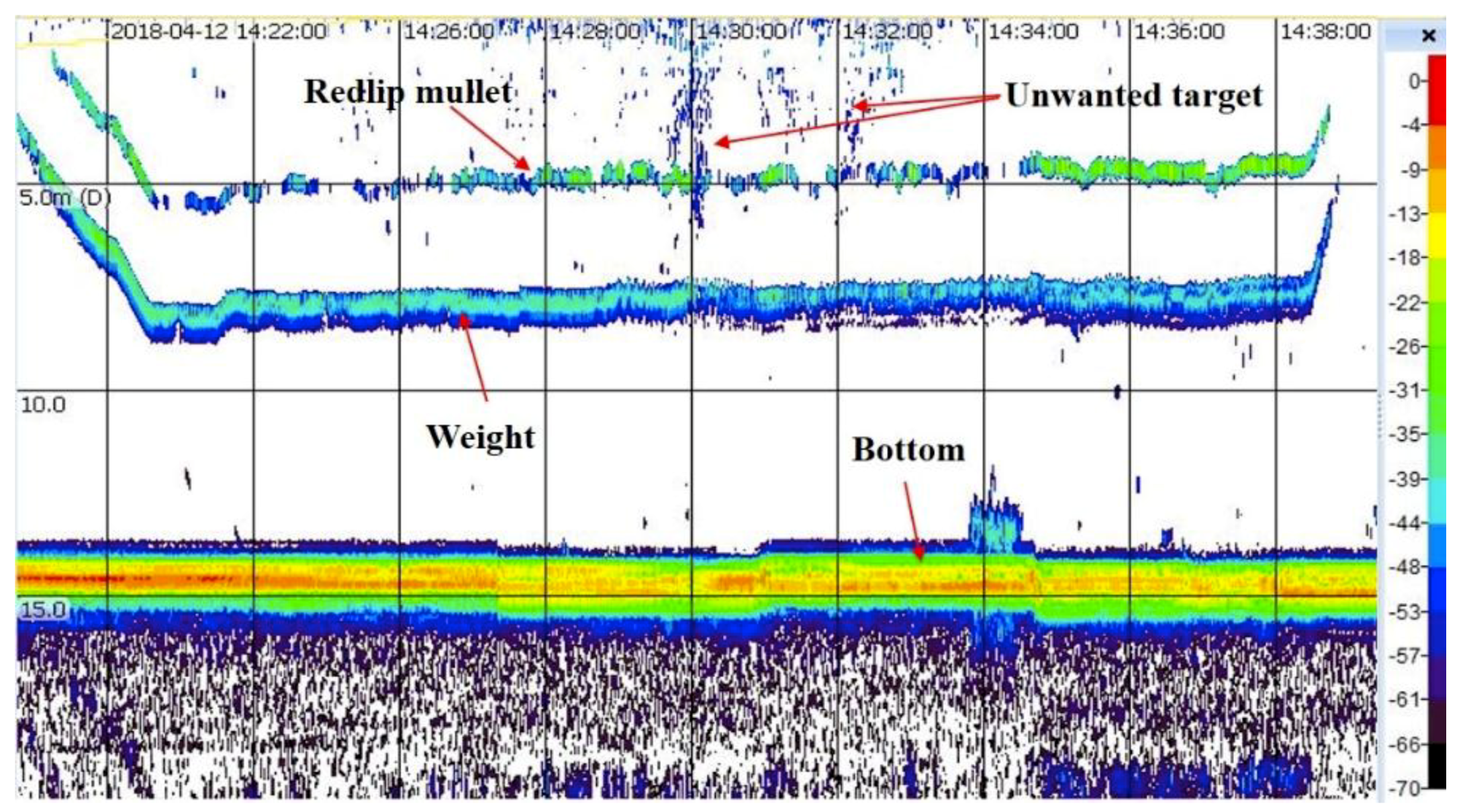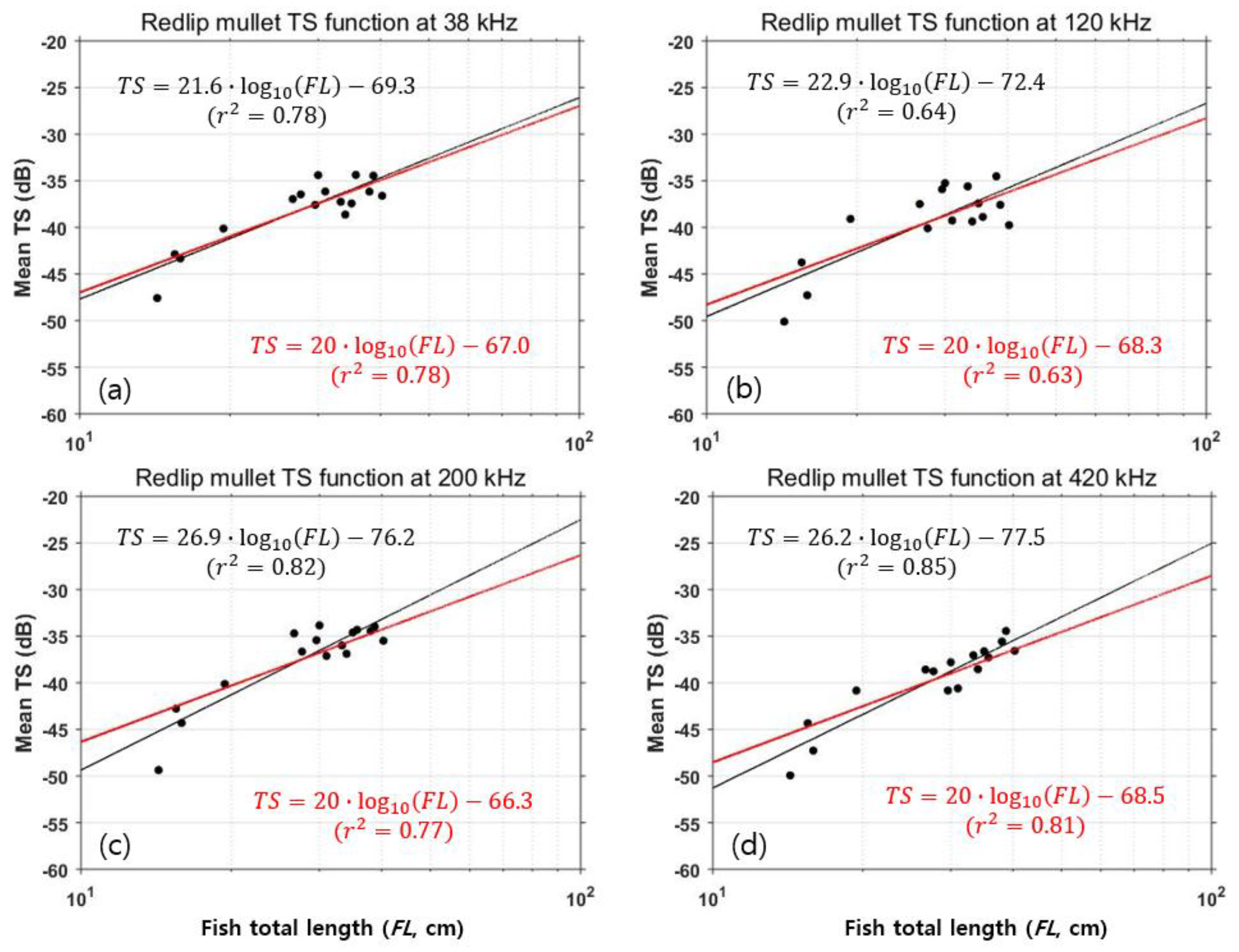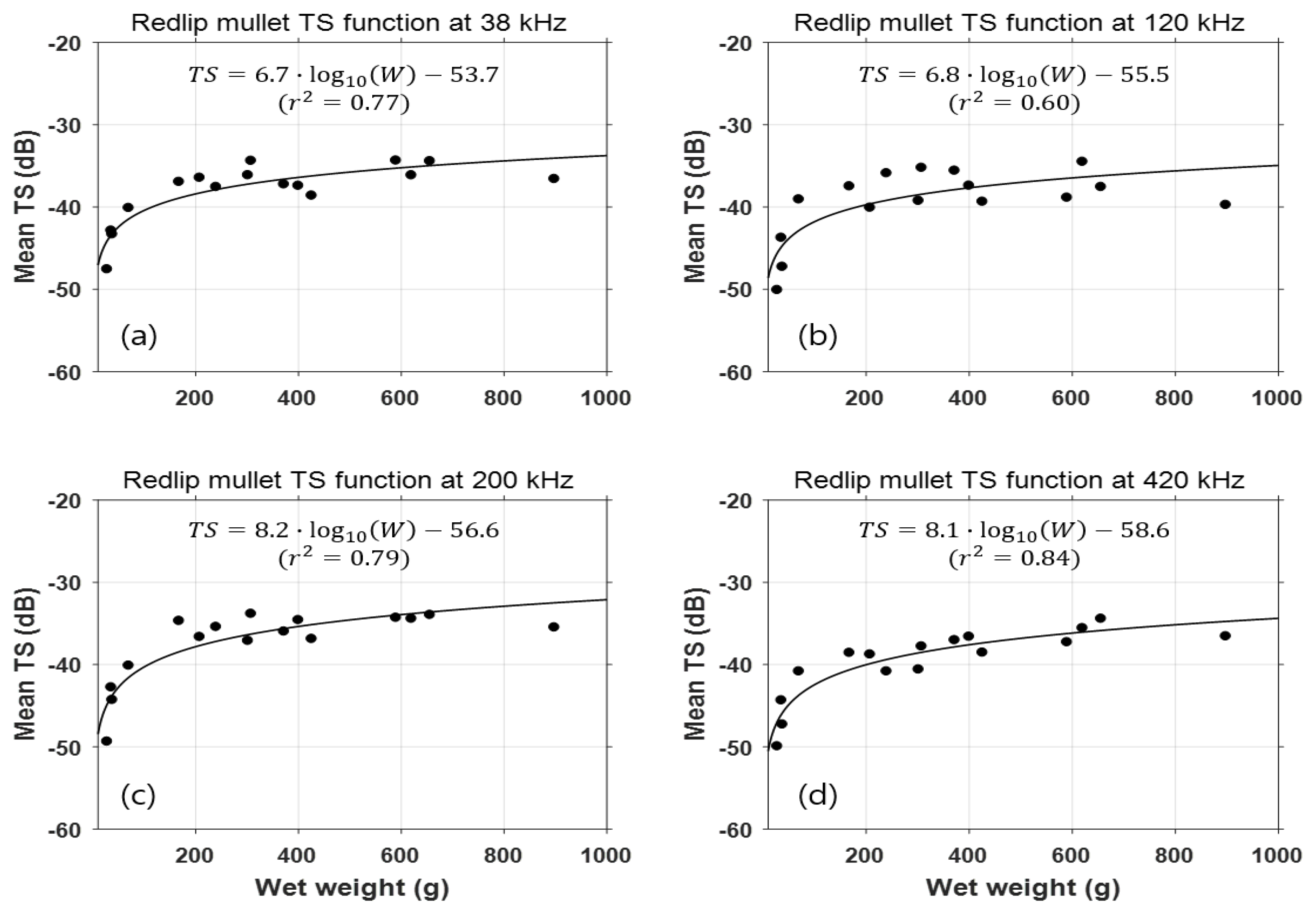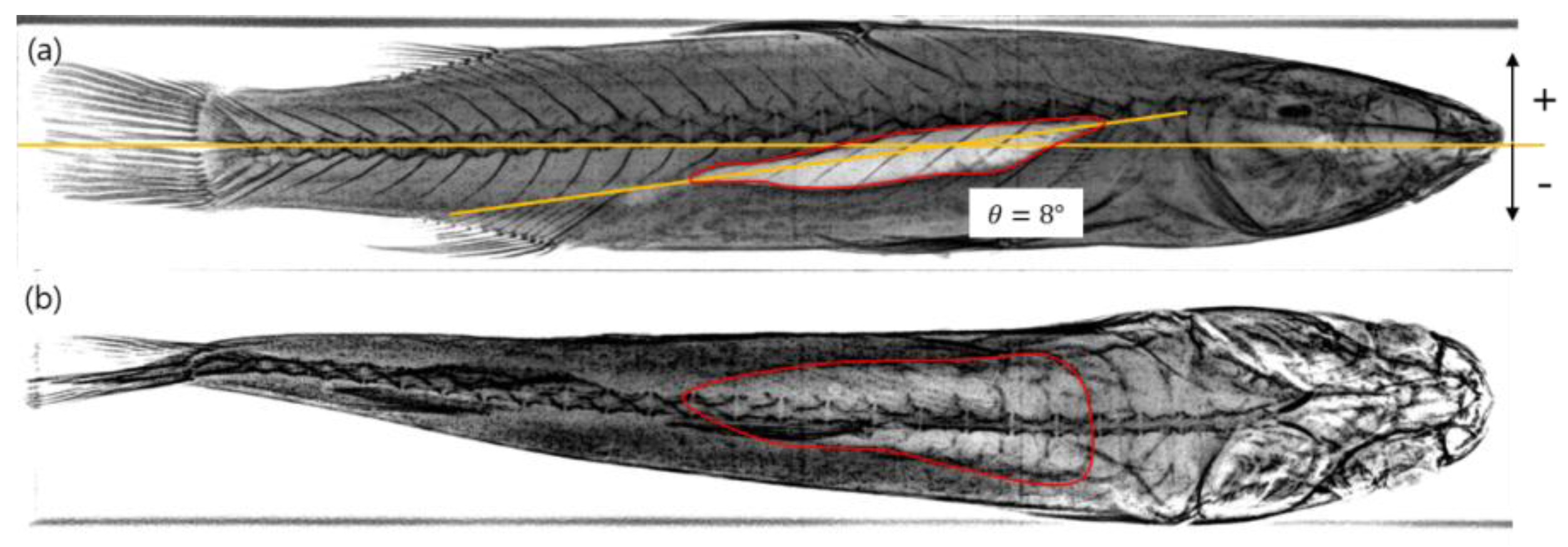1. Introduction
Redlip mullet (
Chelon haematocheilus) is a euryhaline species that inhabits both marine coastal water and freshwater environments [
1,
2]. The species is a commercial aquaculture fish in Korea and has an ecological niche in the marine ecosystem [
2,
3]. It is widely distributed around the coastal waters of Korea, Japan, Taiwan, and China in the North-Western Pacific Ocean [
4]. The young mullet feeds on phytoplankton or small organic sediments in coastal waters and the adult mullet becomes omnivorous [
5].
The traditional netting method has been used to measure the abundance of mullet in coastal waters [
6]. In addition, the biomass of mullet in aquaculture nets has been estimated by the total wet weight (
W) using a scale. As these methods are labor intensive and costly, it is necessary to consider more efficient methods. Since 2000, a hydroacoustic method using the acoustic equipment of fisheries has been implemented to estimate the distribution and abundance of fish in marine and freshwater environments [
7]. Hydroacoustic methods are considered to be an efficient way to overcome the limitations of traditional methods [
8,
9].
The acoustic target strength (
TS) of individual fish and volume-backscattering strength (
Sv) from fish schools must be obtained using well-calibrated acoustic equipment to determine an accurate biomass of a target fish. The
TS information is required in order to convert
Sv to absolute fish biomass. The accuracy of the
TS information is a key parameter that determines the accuracy of the biomass estimate. Previous studies have reported that the
TS information can cause up to 40% of the error in the biomass calculation [
7,
10].
TS is generally measured directly in in situ or
ex situ experiments and indirectly use an acoustic scattering model [
11]. The in situ method has the advantage of obtaining
TS data in the natural state for the target fish, but it is difficult to distinguish the
TS data due to other fish or unwanted fish [
12]. The
ex situ method uses tethered or caged live fish and has some advantages, such as species identification, tilt angle, and fish information (length and weight), but there is a possibility for error in the
TS measurements due to unnatural movements from the artificial control [
13]. The acoustic scattering model, based on physical morphology, estimates
TS information at various frequencies and fish lengths, but it depends heavily on internal physical characteristic data (body or swim bladder shape, density gradient, and sound speed gradient) of the target fish [
14]. There has been a tendency to use all three of these methods together to obtain more accurate
TS data.
Considering labor and costs, acoustic methods that use high frequencies are a very efficient methods for obtaining rapid biomass estimates of cultured Redlip mullet (Chelon haematocheilus). Unfortunately, there is very little information about TS measurements and related information on this mullet species.
The purpose of this study was to measure the TS of cultured Redlip mullet, which is the key parameter for estimating biomass using the acoustic technique. As a result of this study, we derived the relationship between the TS function and the total fish length (FL, cm) or wet weight (W, g) at frequencies of 38, 120, 200, and 420 kHz. Furthermore, we tried to understand TS characteristics based on the swimming angle.
3. Results
In this experiment, the seawater temperature was 13 °C, and salinity was 32 psu, so the speed of sound was 1496.7 m/s [
7]. The 16 live mullets were judged to be in good condition during the experiments. Their total fish length (
FL, cm) ranged from 14.3 cm to 40.3 cm (mean
FL = 29.07 cm) and their wet weight (
W) ranged from 28 g to 898 g (mean
W = 335 g). The relationship between the
FL and
W is:
W = 0.0004825,
FL3.884 (
r2 = 0.97).
Figure 3 shows a sample echogram of a mullets
TS measurement (
FL: 35.0 cm, 200 kHz). In the echogram, the
TS data from the mullets were fully separated from unwanted surface targets, weight, and the bottom. The relatively low
TS value (about −50 dB) at the beginning of the measurement was likely to be due to the unstable condition of the mullet at the tethered depth. The higher
TS values (about −33 dB) show that the mullet was stable with an approximate ±5° tilt angle. The mean
TS for mullet was calculated from the
TS data obtained between 14:26 and 14:38.
Representative samples of the
TS distributions at 38, 120, 200, and 420 kHz are shown in
Figure 4. Generally, the
TS of a fish with a large motion during
TS measurements have a typical Rayleigh distribution, and thus the deviation of the mean
TS tends to be large. However, the
TS data measured in this study show similarity with the Gaussian distribution, and thus show relatively stable mean
TS values. The numbers of valid
TS data (745 at 38 kHz, 656 at 120 kHz, 454 at 200 kHz, and 460 at 420 kHz) were considered to be sufficient to calculate a mean
TS value for mullet. The
TS values for mullet, ranged from −52.4 dB to −30.6 dB at 38 kHz, −58.4 dB to −28.6 dB at 120 kHz, −57.0 dB to −26.4 dB at 200 kHz, and −59.2 dB to −27.0 dB at 420 kHz. The mean
TS values from the data were −37.4 dB at 38 kHz, −37.4 dB at 120 kHz, −34.6 dB at 200 kHz, and −36.6 dB at 420 kHz.
Figure 5 shows the relationships between the mean
TS and the
FL at each frequency. The black points are the mean
TS values from the 16 mullet, which ranged from −47.6 dB to −34.4 dB at 38 kHz, −50.1 dB to −34.5 dB at 120 kHz, −49.4 dB to −33.8 dB at 200 kHz, and −49.9 dB to −34.4 dB at 420 kHz. Considering the mean
TS values for all frequencies, the difference in the maximum mean
TS was within 1 dB and the difference in minimum mean
TS was 2.5 dB. These results indicate that the frequency dependence of the mean
TS value was relatively low.
From Equation (2) using the mean
TS data, it is determined by the least-squares regressions of mean
TS with
FL. The
TS functions at all frequencies were fitted for Redlip mullet (
Figure 5),
where
is the coefficient of determination, and CI is the confidence interval for
m and
n. The mean
TS values for each frequency were calculated from the standard fits of the
TS function (see Equation (3)). The relationships between mean
TS and
FL were derived with the following equations (
Figure 5):
The relationships between mean
TS and
W at each frequency were derived using Equation (4). The relationships between the mean
TS and
W were derived with the following equations (
Figure 6):
4. Discussion
According to fisheries statistical data, about 5839 tons of mullet were cultured in 2012, which was 7.7% of the total amount of fish cultured in Korea [
18]. Redlip mullet is a valuable aquaculture species in the northwest Pacific Ocean that is mainly cultured along the coast of the Yellow Sea and the South Sea of Korea [
3,
4,
19]. Until now, the traditional method of weighing was used to calculate the biomass of mullet on a fish farm [
6]. This method requires a high cost, time, and human labor to estimate biomass. Using a hydro-acoustic method is an alternative way to overcome these limitations [
7].
Research and development of an automatic fish-counter system, based on the hydroacoustic technique, are underway in Korea. One of the most important parameters for applying this system to a fish farm is to understand the acoustic TS characteristics of the target fish. The TS information of Redlip mullet was unknown before this study.
In fisheries acoustics, the target strength (
TS) functions are essentially required to convert volume backscattering strength (
Sv) to absolute fish biomass. The accuracy of the
TS information is a key parameter that determines the accuracy of the biomass estimate. In more detail, the
Sv value within depth intervals can be changed to volume-backscattering area (
SA) for every one nautical mile of survey transect. By assuming that measurements of
Sv represent the linear sum of echoes from individual fish within the sample volume, the numerical density of fish (number per unit area of sea surface) can be estimated by dividing
SA by the backscattering cross-section (
, m
2) of a single fish. Biomass density of fish (ρ, g m
−2) can be estimated by multiplying the numerical density by the weight of a single fish [
20].
The
TS of individual fish is influenced by the tilt angle and the volume of the swim bladder. As the volume of the swim bladder in the body is difficult to calculate directly, the mean
TS is expressed as a function of fish length or weight. Generally, the larger the fish length, the greater the swim bladder volume, and hence the larger the
TS. The swim bladder is the most important factor affecting the
TS of fish. In particular, it is known that more than 90% of the
TS value is related to the size of the swim bladder [
7]. Generally, a higher
TS value is obtained when the tilt angle between the incident wave and the swim bladder area is perpendicular.
After the
TS experiments, the swim bladder shapes were obtained using radiography (M-1005; Softex, Mumbai, India). The lateral and dorsal views were acquired from X-ray images of frozen mullet (
Figure 7). The mullet’s head and back are flat-shaped and the body is wide, unlike other fish in the dorsal direction. In the case of Redlip mullet, the swim bladder has a positive inclination relative to the body axis and the tilt angle of the swim bladder was about 8° from horizontal.
Figure 8 shows the relationships between mean
TS and the tilt angle at 200 kHz for 19.4 cm and 35.0 cm
FL values. The tilt angle was calculated by extracting the time-synchronized capture images from an underwater camera. At that time, the
TS values could not be obtained at all angles. As a result of the relationship between the tilt angle and mean
TS, the
TS values were about −35 dB and −32 dB for tilt angles of −10° to 0°, respectively. The closer the tilt angle of the swim bladder is to horizontal, the higher the
TS value. The
TS value tended to decrease for tilt angles less than −10° or more than 10°. The mean
TS values were −41.4 dB and −38.0 dB when considering a tilt angle of ±20°, which is normal for fish swimming in a sea cage.
The swim bladder is generally inclined +15°–30° in the positive direction from the horizontal compared to other fish [
21]. Therefore, the highest
TS value occurred when the tilt angle of the fish body was between −30° and −15°. Considering the characteristics of the acoustic signals transmitted in the vertical direction when the inclination angle of the swim bladder is high, the
TS value of the fish also varied widely due to transmission and reflection fluctuations depending on the tilt angle at high frequency. In this study, the difference in the
value in the standard
TS function at each frequency was within about 2 dB (Equations (9)–(12)). Generally, fish with large swim bladder angles in
TS measurements have relatively high
TS values at low frequencies. In the case of the mullet with small swim bladder angles, the difference of mean
TS, with frequency, was relatively small because the slope of the swim bladder is almost parallel with a horizontal line. These results show that the
TS functions are consistent at all frequencies (
Figure 5 and
Figure 6). However, the reason why the result at 120 kHz is lower than that of the other frequencies is that the coefficient of determination for the accurate beam axis was relatively low at the time of the
TS experiment.
Most fish in a sea-farm cage move predictably without sudden movement. The difference in the TS values between tilt angles of +20° and -20° was about 10 dB. Considering the relatively small fluctuation in the TS values at all frequencies in this study, the high frequency is valid to use when estimating fish biomass within a confined net at a fish farm.
The results of this study will provide TS information for Redlip mullet and can be applied to estimate biomass. In future studies, we will attempt to calculate the theoretical TS using morphological parameters, such as the three-dimensional swim bladder and the body shapes and the physical properties of Redlip mullet for a numerical simulation with a scattering model. In addition, we will compare and analyze the measured TS data with theoretical TS data to improve the accuracy of the TS information.
